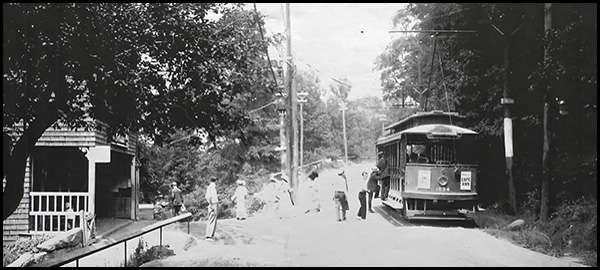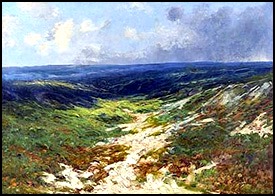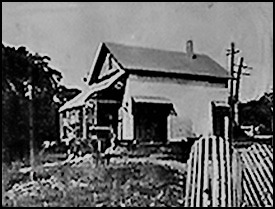


During the summer months from 1902 to 1904 Tommaso Juglaris and Henry Hammond Gallison worked virtually side by side in the latter’s cove-side studio at Annisquam, Massachusetts. While Juglaris painted Grecian Festival and The Hours for the new Ray Memorial Building housing the Franklin Public Library, Gallison was focused on finishing a cycle of four enormous paintings, The Deserts of the World, intended to embellish the library’s delivery room. Although Annisquam was a place of retreat for both artists, reporters from the Boston papers interested in their creative output had no difficulty finding and interviewing them. Each garnered their share of publicity and, as much as they may have regarded it as a nuisance, perhaps welcomed it.
Like Juglaris who did not always feel appreciated by Americans, Gallison stood apart from much of the rest of the Boston art establishment—an artist without honor within his own country, at least outside his own respected sphere in Annisquam. The Boston Sunday Post reporter who interviewed Gallison in June 1903 noted: “He received honorable mention at the Paris Exhibition. He does not care for his own country’s approval; of his works, saying ‘What does a medal amount to here? Everything is run by cliques. A little body of artists gets together and decides to give Johnny Smith a medal because he is their friend, and next year someone else gets it. Now, in other countries a commission appointed by the government decides on the medals, and a picture stands on its own merits, the commission not knowing the artist personally. A man’s country does not recognize him anyway until he has been approved by some other." The reporter added: “Mr. Gallison has exhibited in nearly all the art galleries of Europe for the past few years.”

A year later, in August 1904, on the occasion of the purchase by the Italian government of one of Gallison’s landscape paintings, a reporter from the Boston Sunday Globe further elicited his views on the larger art enterprise. Once again, Gallison was very forthcoming, revealing no small measure of pride in his own talents. As the journalist recounts: “Step off the [Cape Ann trolley] car and see Mr. Gallison, and you will feel yourself at once in touch with a force in American art. A small, smooth-shaven, bright-eyed man is Mr. Gallison, the opposite of what one might expect from the heroic pictures he paints, for he loves big canvases and broad effects. When he talks of art and Annisquam Mr. Gallison’s face lights splendidly, and his language is poetry. ‘I have been studying nature here for more than 20 years,’ he said, ‘and I know its moods. People here look at my paintings and say ‘Where is that scene? It is Cape Ann, of course, but where?’ They never know for the scenes I present do not exist. I take what I want out of nature and create a picture from it. I know how the sun looks on foliage; I have studied the sand on the dunes in the moonlight; I know what the mists are like as they come over the hill from seaward, for I have seen them many a morning in the dawn, creeping over the treetops. It is all stored in my memory, and I use what I want from it.’ ‘Why,’ said Mr. Gallison with animation, ‘when a poet starts to write a sonnet he does not copy the dictionary. Neither does an artist copy nature. A painter may; but an artist never. That is the difference between artists and painters…’”

The reporters from the Boston Post and Globe enjoyed meeting Juglaris as much as Gallison, possibly even more. Juglaris was described as “the celebrated Italian figure painter.” Besides offering a verbal portrait of Juglaris as the great artiste, they had the highest plaudits and enthusiasm for his dual commission, Grecian Festival and The Hours. The Boston Sunday Post correspondent remarked in an early article published in September 1902: “Mr. Juglaris is very popular in the little artist colony at Annisquam. One artist said he is the most generous and true as an artist, never giving untrue criticism of others and always giving each his just due in artistic merit.” The correspondent then gave an account of his personal encounter with Juglaris: “Mr. Juglaris speaks rather broken English, which makes his conversation interesting, as he holds the entire attention of the listener. He is genial and sees the humorous in everything. He says of his work: ‘I feel all that I paint. I paint not all that I feel because I am doing this work too quickly, but had I a year, two years. Ah! I would do—so much.’ He also said on the subject drifting to that of his country: ‘I like Italy. I have been in England, Belgium, and France, but I like America best.’” The writer concluded: “Mr. Juglaris is very versatile. He not only paints decorations but can do equally well portrait painting, landscape, and designing. He studied industrial art in Paris, and finds this to be of great aid to him in many ways. He did the beautiful decorating in [Boston’s] St. Peter’s and St. Paul churches…”
The spectacular size of Juglaris’s Grecian Festival mural, as well as the fact that its theme was completely consonant with the Greek-style architecture of the new Ray Memorial Building, particularly impressed reporters. They kept repeating the measurements of the mural cycle and emphasizing how well suited it was for the site. The Boston Post writer recorded that “the first designing” of Juglaris’s mural “was begun June 1 [1902]” and that “the painting began July 7.” Overestimating Juglaris’s likely progress, the correspondent projected that Grecian Festival “will be complete about the middle of September.” In fact, Juglaris was only ready to exhibit his work in outline form that fall. It was another two years before both Grecian Festival and The Hours were finished, installed in place at the library, and ready to be dedicated.
As they neared completion, Juglaris’s Grecian Festival murals and his friezes depicting The Hours were not without controversy. Surviving legend in Franklin, Massachusetts, reports that the nudity of some of Juglaris’s figures scandalized local residents. Accordingly, at some point he was asked to dress them, which he did with filmy gowns that still reveal as much as they conceal. The furor in Franklin over Juglaris’s naked figures was not unlike the contemporaneous public outcry over Frederick MacMonnies’s nude statue, Bacchante and Infant Faun, intended for the courtyard of the Boston Public Library. To whatever extent Juglaris satisfied Franklin’s demand for greater decorousness, he does not seem to have compromised his murals and friezes aesthetically.